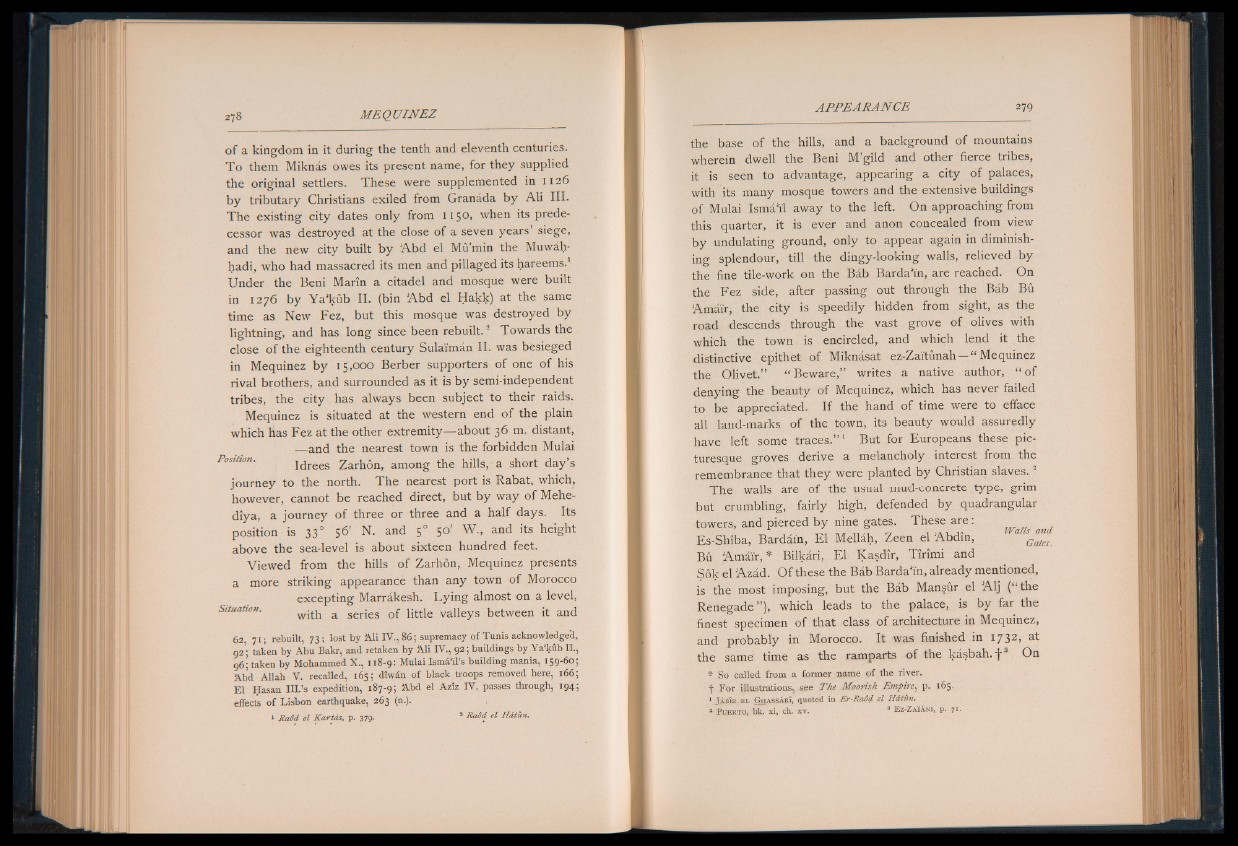
o f a kingdom in it during the tenth and eleventh centuries.
To them Miknas owes its present name, for they supplied
the original settlers. These were supplemented in 1126
by tributary Christians exiled from Granada by Ali III.
The existing city dates only from 1150, when its predecessor
was destroyed at the close of a seven years’ siege,
and the new city built by A b d el Mumin the Muwah-
hadi, who had massacred its men and pillaged its hareems.1
Under the Beni Marin a citadel and mosque were built
in 1276 by Y a ’kub II. (bin Abd el Hakk) at the same
time as New Fez, but this mosque was destroyed by
lightning, and has long since been rebuilt.2 Towards the
close of the eighteenth century Sulaiman II. was besieged
in Mequinez by 15,000 Berber supporters of one of his
rival brothers, and surrounded as it is by semi-independent
tribes, the city has always been subject to their raids.
Mequinez is situated at the western end of the plain
which has Fez at the other extremity— about 36 m. distant,
— and the nearest town is the forbidden Mulai
Position. idrees Zarhon, among the hills, a short day’s
journey to the north. The nearest port is Rabat, which,
however, cannot be reached direct, but by way of Mehe-
diya, a journey o f three or three and a half days. Its
position is 330 56' N. and 5° 50' W., and its height
above the sea-level is about sixteen hundred feet.
Viewed from the hills of Zarhon, Mequinez presents
a more striking appearance than any town of Morocco
excepting Marrakesh. Lying almost on a level,
Situation. w ith a s e r ie s Qf little valleys between it and
62 71; rebuilt, 73; lost by Ali IV., 86; supremacy of Tunis acknowledged,
92’- taken by Abu Bakr, and retaken by Ali IV., 92; buildings by Ya%ub II.,
96; taken by Mohammed X., 118-9: Mulai Ismael’s building mania, 159-60;
Abd Allah V. recalled, 165; dlwdn of black troops removed here, 166;
El Hasan IIL’s expedition, 187-9; Abd el Az5z IV- P ^ 63 through, 194;
effects of Lisbon earthquake, 263 (n.).
1 Kaod e l Kartds, p. 379. 1 Ra$d el Ihitiln.
the base of the hills, and a background of mountains
wherein dwell the Beni M’gild and other fierce tribes,
it is seen to advantage, appearing a city of palaces,
with its many mosque towers and the extensive buildings
of Mulai Isma‘i'1 away to the left. On approaching from
this quarter, it is ever and anon concealed from view
by undulating ground, only to appear again in diminishing
splendour, till the dingy-looking walls, relieved by
the fine tile-Work on the Bab Barda’in, are reached. On
the Fez side, after passing out through the Bab Bu
Amair, the city is speedily hidden from sight, as the
road descends through the vast grove of olives with
which the town is encircled, and which lend it the
distinctive epithet of Miknasat ez-Zai'tunah —“ Mequinez
the Olivet.” “ Beware,” writes a native author, “ of
denying the beauty of Mequinez, which has never failed
to be appreciated. If the hand of time were to efface
all land-marks of the town, its beauty would assuredly
have left some traces.” 1 But for Europeans these picturesque
groves derive a melancholy interest from the
remembrance that they were planted by Christian slaves.2
The walls are of the usual mud-concrete type, grim
but crumbling, fairly high, defended by quadrangular
towers, and pierced by nine gates. These a re :
_ _ 1 t . . « . » i j a W a lts a n d
Es-Shiba, Bardain, El Mellah, Zeen el Abdin, Gates
Bu Amair,* Bilkari, El Kasdir, Tirfmi and
Sok el Azad. Of these the Bab Barda’i'n, already mentioned,
is the most imposing, but the Bab Mansur el Alj (“ the
Renegade” ), which leads to the palace, is by far the
finest specimen of that class of architecture in Mequinez,
and probably in Morocco. It was finished in 1732, at
the same" time as the ramparts of the kasbah. j- On
* So called from a former name o f the river.
f For illustrations, see T h e Moorish Em p ire , p. 165.
1 Jabir e l Ghassari, q u o t e d in Er-Ra6d el H&tiin.
2 P u e r t o , bk. xi, ch. xv. 3 E z - Z a l a .n i , p. 71.